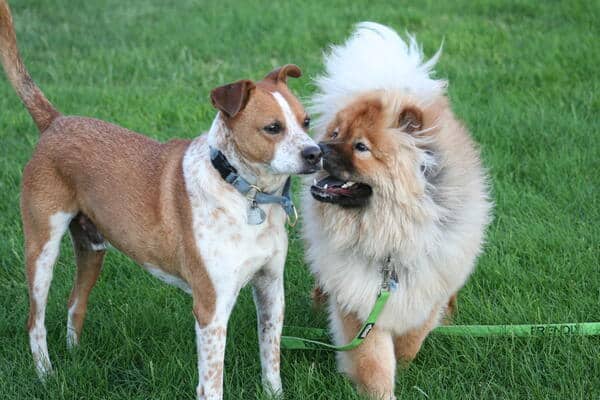Perhaps the most misused term of all in describing dog behavior, and with so many definitions. Enough that many knowledgeable dog professionals have stopped trying and abandoned using the term.
We’ll look at how the meaning has evolved, and it’s current use in ethology. Then how it’s being misused with dog behavior, and how to approach those issues.

The Dominance Definitions
Dominance in ethology is an “individual’s preferential access to resources over another”
Wikipedia
In ethology, dominance is used to describe an asymmetric relationship between two animals, in which one animal has more influence over the behavior of the other than vice-versa.
John Bradshaw Ph.D., Psy Today
Dominance is defined in animal behavior as a relationship between individuals that is established by force, aggression and submission in order to determine who has priority access to multiple resources such as food, preferred resting spots, and access to mates.
Sophia Yin, DVM, Sept 2009
Over the years, Sophia Yin and others have tried to define ethological dominance without recognizing that it has evolved and that ethologists do not agree, and there Yin gave the old definition, while Bradshaw and Marc Bekoff will still differ, but are using newer and more general definitions.
Even Yin’s comments above on access to mates, is just one more item that is often variable.
for many years it was assumed that dominant animals mated the most and controlled access to various resources. Now we know this isn’t necessarily so in all species or even within different groups of the same species. Often, less dominant or subordinate animals are able to mate and can control others in different contexts.
Marc Bekoff 2012
Three people, and three different views. The first has a focus on resources, while the second on the behavior of each individual. The third is the older one, which materially relies on force.
And that now brings it closer to the common definition. Note the absence of force and resources there, which says they may be a part of this, but are not necessary. And perhaps the most important aspect of this newer definition is that it is something that most people can easily understand, reducing confusion and more long-winded definitions.
For a more general form, one might say dominance relates to control over resources, both material ones and the behaviors of others.
That removes both any requirement for aggression, or for the dominant individual to take personal access, as in instead directing food resources to young pups. I believe that definition relates better to common usage, and even includes human businesses with a manager and workers.
On the Finding of Dominant Behavior
If there is no assumption of a dominance-based system, one is seldom identified. When free-ranging baboon interactions were classified by behavioral types (e.g., friendly, approach- retreat) and then analyzed according to specific behaviors of the participants, no dominance system was noted.
Karen Overall
Which only says that it will not be always present, especially in non-stressed, complex social groups. However, animals such as chickens may present somewhat differently.
And this also goes further, depending on the derived behaviors you are willing to associate with dominance. Many people have found dominance in dog groups who are free-ranging and feral. Marc Bekoff mentions this in a dog park. However, if I move from a dog park where the dogs are only lightly socialized, to one where they are much more extensively socialized with both dogs and people, I submit that most dominance indicators will appear very different. Often so different as to hardly be recognized as such.
We investigated the existence of a social-dominance hierarchy in a free-ranging group of domestic dogs. We quantified the pattern of dyadic exchange of a number of behaviors to examine to what extent each behavior fits a linear rank-order model. We distinguished among agonistic dominance, formal dominance, and competitive ability. The agonistic-dominance hierarchy in the study group shows significant and substantial linearity.
Cafazzo, et. al.
Note that this takes things to a new level. I don’t know of any dog trainer or behaviorist who considers those three types of dominance, or the linearity of their rank-order model. So it seems that dominance is not simply in the eye of the beholder, but also related to the complexity of the definition, the species, and the cultural environment. That last item relates to my note about two very different groups of dogs at a dog park. And is also emphasized by the next quote about a group of dogs.
…this group was not particularly egalitarian. Division between ranks was nearly always strict, requiring a dog to greet his superior, even one just a single rank above him, with deferential behavior such as lowered body posture.
Dr. Hekman, Netherlands
Yet, my second dog park example had none of that happening, unless they are joined by a very new and young pup just learning. The main difference between those two groups being learned social behaviors (resulting in a different cultural environment).
From this I would say that the type and form of dominant behavior is dependent not only on the species, but also the local environment (resources and threats) and prior learned behavior.

Aurora, the Malamute, entering the dog park to see her friends. None of these dogs show strong or ritualistic dominance. No, the dog on the right is only showing a submissive pose she uses with all dogs that she greets, and will quickly drop that during play.
The Dominant Conclusion
As you would find in the following articles (and their internal references), dominant behaviors actually often exist in higher mammals, but their form varies with not only the species, but also their environment. And much of that has little or nothing to do with many of the dog behavior issues which we commonly ascribe to dominance. So, we will continue on now, from the limited aspect of a dog as a pet and companion.
Dogs Display Dominance: Deniers Offer No Credible Debate – Marc Bekoff
Social Dominance Is Not a Myth: Wolves, Dogs, and – Marc Bekoff
Dominance and Pseudoscience: Making Sense of Nonsense – Marc Bekoff
From a Dog Trainer
Did you know that dominance when referring to dogs is not a personality trait? It is a complex construct and actually has many definitions depending on which field of science one is referring to for the definition. Whole books have been written about it. The relevance this has to dog training is that when one describes a dog as being a “dominant dog” the word is usually being used incorrectly and simplistically. A dog may show dominance in relation to another dog in a particular situation at a certain moment in time over a certain resource that they really want more than the other dog … but this may only be applicable for that particular situation at that moment in time over that particular resource. It may well change the very next day or in a different situation or be reversed with a different interaction with the same dog. It is not the dog’s personality.
Dog Charming April 9, 2016
Yes, but limited resources and stressed environments would then tend to result in more competition between conspecifics. Given that, both learned behaviors and personality will determine which individuals are more likely to present with dominance behaviors. Therefore, traits will have an influence.
Why is this important?
Dog Charming
If you consider a dog to be a “dominant personality” it may well lead to training methods that are intended to subdue and crush this individual’s strong personality. Methods that take this approach are usually forceful and aversive in nature and there are well documented side-effects to approaching behaviour change in this way. Words matter. Words used incorrectly not only matter but can have unnecessary negative consequences. Once labelled dominant, a dog may go through life being subjected to an adversarial relationship with trainers and guardians who aim to “put him in his place.” Continual interventions to eliminate dominance may subsequently result in self-protective or reactive behaviours being exhibited by the dog. This is then viewed as proof of a dominant personality and subjugating methods are seen as justified as well as intensified. In fact, the reactive behaviours are a dog’s attempt to cope with continual aversive incidents. (An aversive stimulus is something a dog wants to escape or avoid). It’s a vicious cycle and it does little to enhance the human-dog bond but is very effective in whittling it away.
That’s pretty much the old way, that of meeting perceived force with actual force. But the possibility of using forceful and aversive training goes far beyond just dominance, so that issue continues on to many other types of behavior problems and how they are approached by people.
As to why this happens with people, consider for a moment the issues of anxiety in dogs. This is a far more common, complex, and varied issue. But the scared dog will often invoke in people feelings of pity, while the supposedly dominant dog will be seen as a challenge to be fought by force.
Going further, in The Dominance controversy, Sophia Yin adds more confusion by stating that if 4 dominant individuals are brought together, only one will be dominant in the new group, and she ties dominance to aggressive behavior. No, Yin did not consider both situational fluidity studies in canines (which Dog Charming mentioned), and social sharing, and that being dominant is not like being a King for canines. However, her description is actually pretty close for chickens.
Instead, if you think your dog’s being dominant, the focus here should be simply on why and what should be done, because history here clearly shows you’re not about to change the word that many people (including many certified dog trainers) use.
Dumbed down by dominance
Which is the title of a two-part article, by Karen Overall, MA, VMD, PhD, DACVB, CAAB. In this she also speaks of past mistakes in animal research, and describes how and why they went wrong. Between humans and dogs, she notes many of the similarities, and how the two groups co-evolved.
The single most devastating advice ever given to people with dogs is that they should dominate their dogs and show the problem dogs “who is boss.”
Karen Overall
And this one quote revels the single, greatest problem with describing any dog as dominant: That many people will immediately assume the only response to be force, punishment, and strict control.
For anybody interested in this area, I would really suggest reading her two short articles. As the internet is changeable, I’ve added both links to the original, and to locally saved pdf files. Here, I’ll just hit a few of the high notes.
Dumbed down by dominance, Part 1 (pdf)
Dumbed down by dominance, Part 2: Change your dominant thinking (pdf)
Dominance Aggression – the Old Ways
Do you have a dog that you think has dominance aggression? A dog who’s confident and aggressive over many types of resources? As the top dog, he’s outgoing and rarely shows fear postures or what one might call “apologetic” behavior. One moment, he’s as charming as a Casanova on a first date. The next minute, he’s throwing more barks and bites than Mike Tyson at a pre-fight press conference.
Handling Dominance Aggression in Dogs – Sophia Yin
Continuing with the confusion, most dogs who are socially confident do not show aggression, but do understand how to manage desirable resources. Instead, Sophia Yin’s drawing a picture of a dog with severe social skills deficits, who is afraid to ever defer to another dog, and relies on aggression for his own safety. The only dominance she describes is from fear aggression.
First Take Control of All Important Resources
This includes food, furniture, toys, and anything else Rover likes including petting, praise, and playtime. Instead of his controlling these items, you’ll ration these resources as selectively as the Seinfeld Soup Nazi. Also control Rover’s freedom of movement by putting him on leash. For the next several days or week, he should be attached to you or tethered to a tie down in the house whenever people are at home with him.
Once Rover gets the rules you’ve conveyed to him through your actions, the weight of trying to be in charge or wondering how he should react will be lifted off his shoulders.
Handling Dominance Aggression in Dogs – Sophia Yin
While she argues elsewhere against applying physical punishment to the dog, she instead uses control of activity and resources as a punishment, to force the dog’s behavior. And she seems to attribute the dog’s anxiety to their having to be in charge and making so many decisions. Perhaps not an especially strong argument there.
Dominance Aggression – the New
Now more properly called conflict aggression or impulse control aggression, the former label of dominance aggression has resulted in several wrong conclusions. From early dominance tests done just by seeing which pups controlled a bone, to encouraging humans to be at the top of an imaginary hierarchy to control their dogs. Many dogs who were given this label actually had issues based on pathological anxiety, and forceful management by humans simply worsened the situation.
Deference replaces fighting
Fights for status or control are notoriously rare among wild canids, including wolves.
The individual to whom others defer may differ depending on the social circumstances; and status and circumstances are not absolute.
Karen Overall
Common with dog, wolves, and even humans, this happens when social individuals get input from other members of the group before continuing. Hierarchies and those deferring become fluid, depending on the particular time and situation. If you watch dogs play, you’ll notice that many games appear to have a leader. But that the leader may often change. And some dogs will have several others defer to them, while they defer to some other dogs.
Importantly, this is not defined from some dog being dominant, but from other dogs deferring to him.

Bandi, with a dozen youngsters. Many like Poe, the Chow Chow, stop by respectfully to say hello and always respond to him. But, the old man will just lay down and watch them all playing. Bandi has taught hundreds of pups basic social skills. But it’s more fun watching, then dominating.
Packing a Pack
Is your dog in a pack? Are you part of that pack? Maybe a pack leader? Or not? A common pack is only a social grouping of dogs, like a gaggle of geese. But many people have embraced the phrase pack leader, as though that will give them some special type of dominant control over their dog’s behavior. But that attempt often degrades to intimidation, punishment, and frustration, instead of teaching the dog new behavior.
For all the variations and differences in ethological opinions and definitions, I have never seen one which entertains a human as a pack leader for dogs.
The Balanced Pack
This relates to the Balanced Dog Trainer, then invents some theoretical balanced pack of dogs, which often includes an Alpha and how you, too, can become a Pack Leader. I wrote above about experiences at two very different dog parks. Where the dogs at one had limited social skills, and signs of ranking and dominance could be seen. But that the other park, with highly social dogs, showed no signs of that. Many sites seem to indicate that dominance with other dogs can best be handled with some balanced pack. as does Joy with her take on The Balanced Pack.
But, nobody ever defines just what that is! If you were struggling in learning to swim races and I sent you to stay with a pack of experienced swimmers, you’d likely learn from the pack. But if they only played soccer, it would be much less helpful. Or, if your behavior was bad and and those dogs had been taught to be very tolerant and never correct bad behavior, how could you learn anything? For more discussion, see my take on The Balanced Pack.

An example of perfect balance. Both large dogs are pulling very softly, so that little Pepper can hold on.
Changing Canine Behavior
Fixing problematic canine behavior is actually not about control, leadership or mastery of the dog; it’s about increasing the chance that you can signal clearly to the dog, that you have the dog’s undivided attention while signaling, and that you are actually rewarding the behaviors that you desire.
Karen Overall
To rephrase this in terms I commonly use, resolving this (and most other dog behavior issues) is all about effective communication and compassionate teaching. Where I rarely use things like food rewards, but instead lead the dog to a result which they find pleasing. And the main reason I often advise others to use food rewards is less in rewarding the dog (reinforcement), and more in better communicating what you what from the dog. An area in which many people do poorly.
At the least, having the person focus on giving the dog a treat at the right time will often prevent them from doing something inappropriate and confusing the dog. Taking this thought just a bit further, we have clicker training for people.
From misunderstanding of dominance, to erratic training results because your dog (and you) remain confused on what the other is saying. It’s often like the old comic of two people trying to communicate in two different languages. As the confusion increases, they each speak slower and louder, even knowing that will solve nothing.
And effective methods to resolve this issues are no different from what you will find in other blog articles here on other issues. Always realizing that how you effectively communicate and teach the dog will depend on each of you, the environment, and your goals. So just ignore any dominance labels, and work on the actual behaviors.
